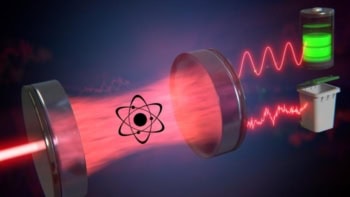Books about the physics community in Nazi Germany, the roots of radio astronomy and a whole lot of nothing, reviewed by Margaret Harris

Morally ambiguous science
Werner Heisenberg was not a Nazi, but his willing service to Hitler’s government as the head of Germany’s wartime atomic weapons project has proved a lasting stain on his character. Max Planck was the dean of pre-war German science and a man whose personal decency impressed all who knew him, yet he was notably quiet in the face of Nazi repression. The chemical physicist Peter Debye left Germany for the US in 1940, but his departure may have been driven by academic politics rather than moral principles. These ambiguities of character – along with many others – are explored thoroughly and thoughtfully in Philip Ball’s book Serving the Reich: the Struggle for the Soul of Physics Under Hitler. Ball focuses on Heisenberg, Planck and the lesser-known Debye because they are neither villains nor heroes. Unlike their fellow Nobel laureates Philipp Lenard and Johannes Stark, who dismissed relativity and quantum theory as a “Jewish conspiracy”, they did not allow ideology to influence their work; however, they did seem to regard their pursuit of scientific truth as a licence to ignore the momentous events taking place around them. The idea that scientists should “rise above politics” still has its adherents today, but in some of the book’s best passages, Ball calls it into question. The biggest problem with the behaviour of Heisenberg, Planck and Debye is not, he suggests, that they failed to actively resist the Nazis. After all, he writes, “it is a brave person who asserts without hesitation that he or she would have done better”. Instead, it is their failure even to engage with the idea that they, as scientists, bore some responsibility for the work they did and the regime under which they did it. Being an “apolitical scientist” is itself a political decision, Ball argues, and as his book demonstrates, it is not always the right one.
- 2013 Bodley Head £20.00 320pp
One universe, one community
The roots of radio astronomy can be traced to the Second World War, when pioneers such as Edward “Taffy” Bowen, Bernard Lovell and Martin Ryle were all part of the British radar effort. In his book A Single Sky: How an International Community Forged the Science of Radio Astronomy, the science historian David Munn explores how the development of this then-new discipline was shaped by the attitudes of such early pioneers and their wartime experiences. The book’s central thesis (and the source of its striking title) is that the early radio astronomers were unusually communitarian by nature. Unlike the “fractious” world of science as a whole, Munn writes, “the radio astronomers saw a single sky, unifying both nations and disciplines”. One reason for this, he suggests, is the novelty of the field and its associated technologies. It is easy to forget that before 1945, the idea that a telescope could look like a radar dish rather than a supercharged version of something William Herschel might have used was little short of revolutionary. At the outset, astronomers and radar physicists had relatively little in common, but the technological demands of the new field forced them to collaborate very closely, and Munn argues that such close collaboration tended to foster a broad respect for people with different, but equally valuable, skills. The field’s interdisciplinary nature also encouraged a trans-national outlook, since the scarcity of scientists equipped with the required skills tended to mean people got hired irrespective of where they were from. (The decision by the US National Science Foundation to recruit an Australian, Joe Pawsey, to lead its new National Radio Astronomy Observatory in 1961 is a good example.) This international flavour, in turn, helped the nascent radio-astronomy community to buck the Cold War trend for yoking science to the needs of the military-industrial complex. These are all interesting ideas, but the academic and occasionally clunky writing style of A Single Sky means that readers will need a keen personal interest in radio astronomy to persevere with Munn’s analysis.
- 2013 MIT Press £23.95/$34.00hb 256pp
The last word on nothing
The latest collection of material from the archives of New Scientist magazine isn’t about why penguins’ feet don’t freeze (2006) or whether polar bears get lonely (2008). Instead, it’s about nothing. Cosmological nothing, mathematical nothing, quantum nothing – whatever flavour of nothing you fancy, Nothing probably has it. The book features essays by 22 different scientists and science journalists on various aspects of nothingness, including the nothing that preceded the Big Bang and the nothing embodied in the mathematical concept of zero. Not all of the essays are about physics or mathematics, however. For example, one thread of essays concerns medications that contain “nothing” – placebos, in other words. Each essay is relatively short, which makes Nothing an excellent companion for those stray moments when you’d otherwise be doing, well, nothing.
- 2013 Profile Books £7.99pb 256pp


